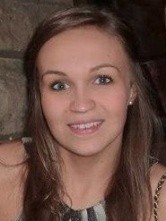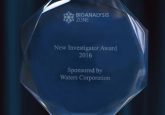2017 New Investigator Award: Lauren Jordan

 Lauren Jordan (LGC, UK)
Lauren Jordan (LGC, UK)
What made you chose a career in bioanalysis?
From an early age I’ve loved learning about the body; from simple daily processes to complex pathways involved in foreign pathogen identification and immune response initiation. Throughout my education the quest to learn more led me to a BSc (Hons) degree in Biomedical Sciences from Durham University, during which I completed a placement year at Quotient Bioresearch, a company focused on delivering high quality analytical and safety services. It was during this year that my interest in bioanalysis peaked, specifically within drug discovery, ultimately leading me to continue my development as a researcher through my PhD at Cardiff University.
Describe the main highlights of your bioanalytical work?
The main highlight of my bioanalytical career comes from the work completed during my PhD. Through the use of in vitro culture techniques and an in vivo arthritis models, I identified two potential novel biomarkers in the arthritides (Jordan et al. 2017, in preparation). The work indicated that the two biomarkers exerted a significant role in the destructive phenotype of bone diseases; through both osteoclast differentiation and resorptive activity. As such, the identification of these novel biomarkers highlighted their potential use in disease diagnosis, monitoring and treatment. Although further research is still needed to establish the true effect of inhibiting these biomarkers in destructive diseases, this data provided the impetus for future work. An additional highlight was being selected to present this data at the annual American College of Rheumatology conference in San Francisco (2015). Providing me with a platform to discuss my research with internationally renowned researchers at the forefront of the field was a significant moment in my career.
How has your work impacted your laboratory, the bioanalytical field and beyond?
The data reported from my PhD implicated two novel biomarkers in early detection of destructive bone disease, supporting several potential future projects in the same laboratory investigating the role of these biomarkers within disease diagnosis, prognosis, targeting/treatment and patient well-being. In addition, inter-disciplinary projects between departments in Cardiff University, and new collaborations with Gothenburg University were made, whilst simultaneously promoting research produced by Cardiff University at international conferences. Although I’m currently working within a separate field at LGC, a company committed to providing high-integrity analytical science and expertise in small molecules and biomarkers, my work involves the optimization of a reliable method of multiple biomarker detection from small sample volume. At their completion, these two projects in tandem could be used for patient sample analysis in various disease stages to identify the importance of biomarkers in diseases (i.e. arthritis), aiding both drug discovery and development in pre-clinical and clinical studies.
Describe the most difficult challenge you have encountered in your scientific career and how you overcame it?
One of the main challenges faced during my scientific career was developing a three-dimensional imaging method for the quantification of resorption pit characteristics after osteoclast culture in medium containing different stimuli; a multi-disciplinary challenge. Hitherto, the currently reported methodology utilized two-dimensional imaging; however, it’s becoming increasingly evident that such 2-D methods fail to report the true resorptive ability of the osteoclast. From internal communications within Cardiff University, a Professor and Biotechnology expert was interested in developing my ideas. Several challenges during the process were met, including; finding a mounting medium which facilitated use of the disk post imaging, optimizing magnification vs. acquisition time, determining the proportion of disk imaged to obtain a representative sample, and how to process the data collected to yield accurate and reliable quantitative data? However, together with the Professor’s expertise in imaging, and my knowledge of the biological pathways, confocal microscopy was used to develop a novel data analysis methodology yielding pivotal information relating to resorption pits that was previously unknown. In combination with recently published data, it is evident that this work has opened the door on an exciting and novel area of research concerning the resorptive capability of the osteoclast in inflammatory diseases.
Describe your role in bioanalytical communities/groups?
Throughout my scientific career I have been a keen member of scientific training groups, aiding the development of new, young, budding scientists at school age through work experience and taster days, to running projects for undergraduate students during their final year, and training new masters and PhD students as they came into the lab. My main role during these projects was to ensure my students had the appropriate skills and knowledge needed to progress their project in a timely manner and achieve reliable and reproducible results of which they could be proud. This role has also transferred into my current work, where I am a coach who supports a new scientist and apprentice who recently joined the company. Additional to this, for a project that I am currently working a great deal of inter-disciplinary communication and learning is occurring between the small and large molecule groups (i.e. discussing LCMS and ELISA extraction methodologies) within LGC, thus ensuring the preservation of high-integrity analytical science whilst also developing the field of expertise within our company. Supplementary to this, communication with logistics teams has enabled optimization of kit productions to compliment and excel LGC’s service to its clients.
List up to five of your publications in the field of bioanalysis:
1Jordan L.A. , Collins F.L., Jones S.A., Choy E.H., Harvey A.K. and Williams A.S. (2014) Inhibiting Autocrine Interleukin-6 (IL-6) Trans-Signalling in Human CD14+ve Monocultures Reduces Osteoclast Differentiation. (Poster presentation at the annual American College of Rheumatology conference).
2Jordan L.A., Davies R., Robertson A.J.D., Harvey A.K., Choy E.H., Erlandsson M., Bokarewa M.I., Errington R.J. and Williams A.S. (2015) Inhibition of Macrophage Inflammatory Protein 1-Alpha (CCL3) Significantly Reduced Bone Resorption in Vitro and the Development of Erosive Joint Pathology in Collagen-Induced Arthritis. (Oral presentation at the annual American College of Rheumatology conference 2015).
3Jordan L.A. (2017) Assessing pain and inflammation in arthritis using novel imaging methods. (Submitted thesis currently unavailable online due to embargo on access allowing for publication).
4Collins F.C., Williams J.O., Bloom A.C., Singh R.K., Jordan L.A., Stone M.D., McCabe L.R., Wang E.C.Y. and Williams A.S.(2017) CCL3 and MMP-9 are induced by TL1A during death receptor 3 (TNFRSF25)-dependent osteoclast function and systemic bone loss. Bone 97; 94-104.
Find out more about this year’s New Investigator Award, the judging panel and the rest of our nominees.






